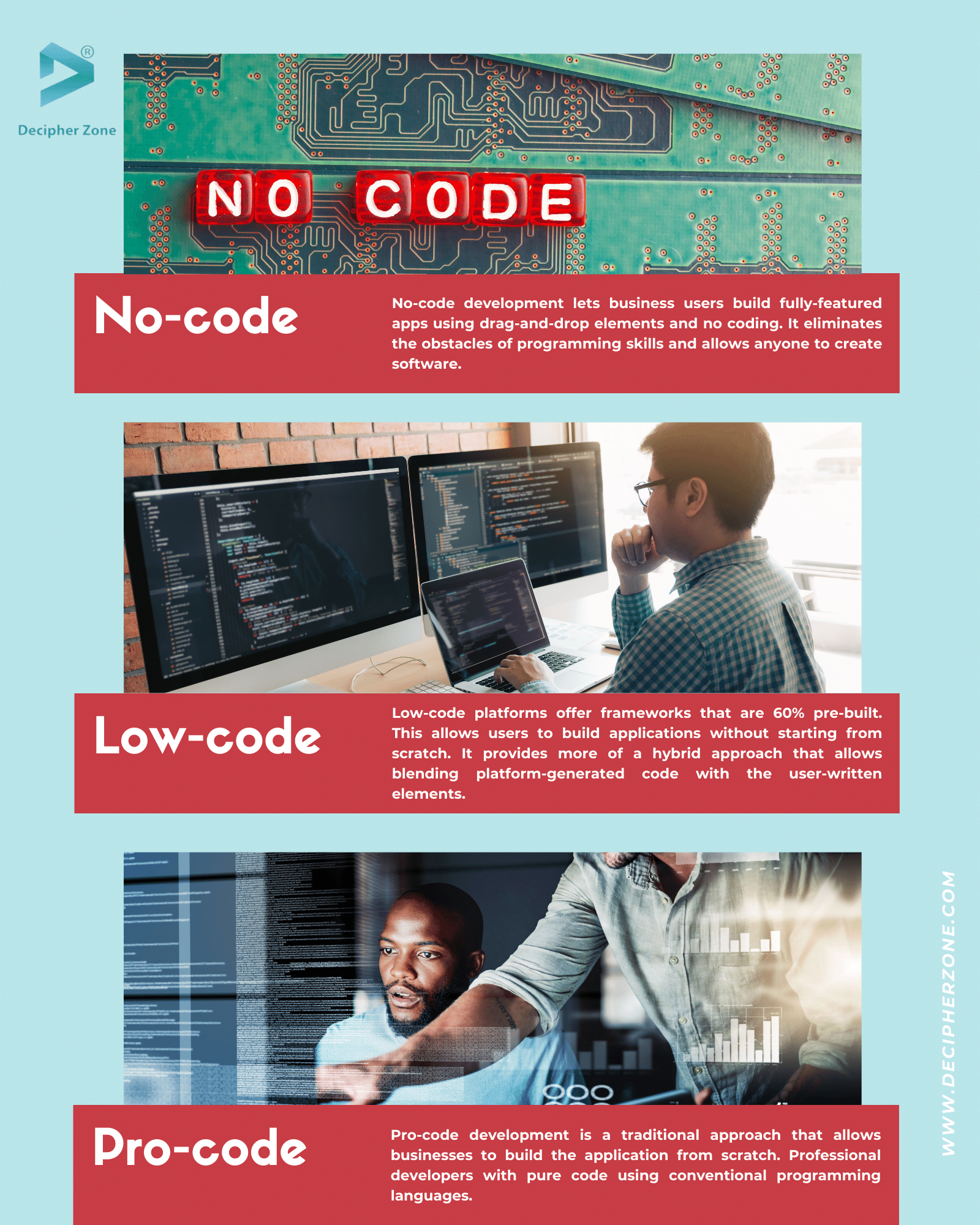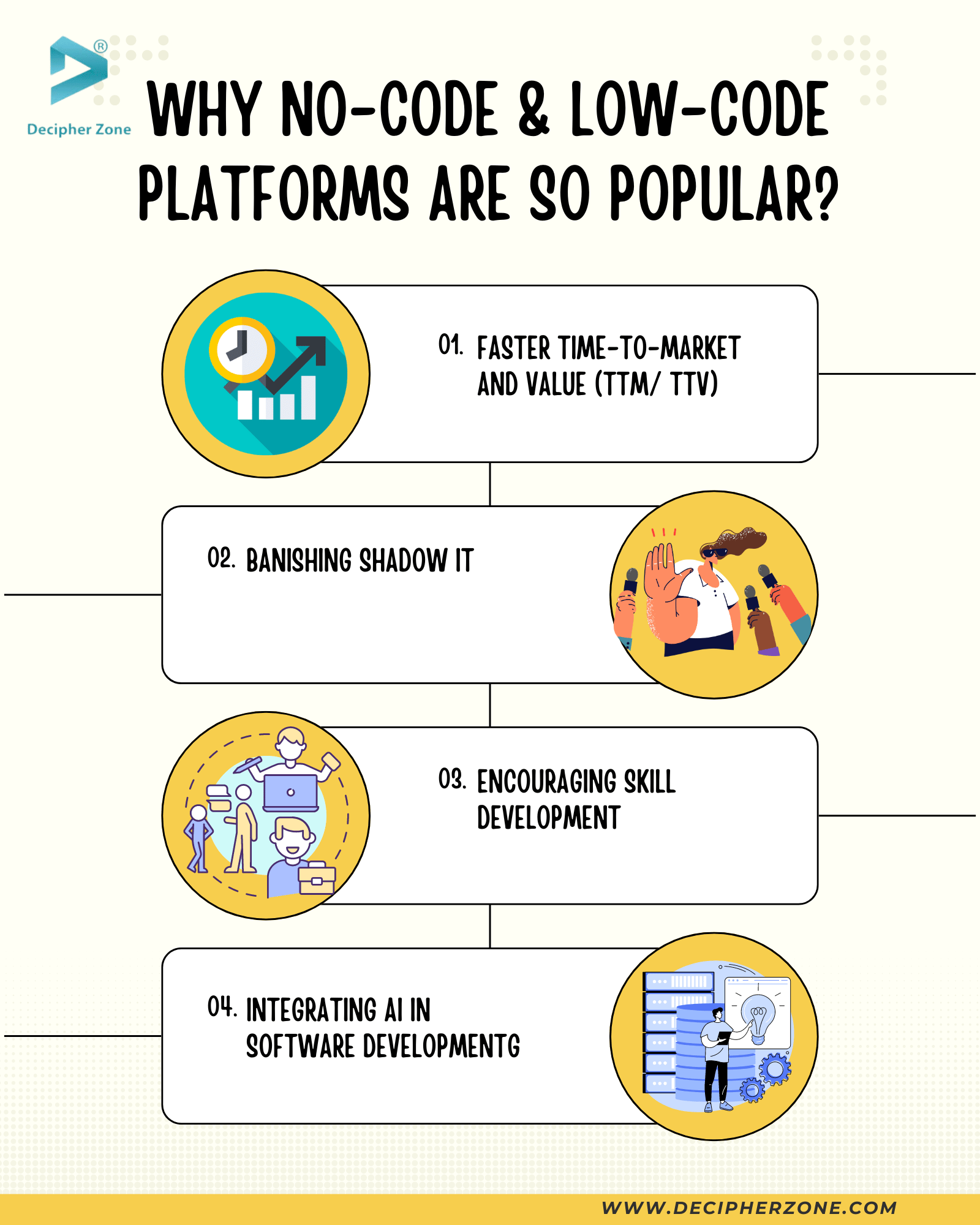Understanding the Differences: No-Code vs. Low-Code vs. Pro-Code. Businesses are no longer limited to developers or software companies when it comes to software or app development and design.
However, to ensure their software works efficiently and effectively, businesses may need development expertise from software companies to stand out from the competition.
No-Code Vs Low-Code Vs Pro-Code: Key Differences and Benefits
No-code, Low-code, and Pro-code developments are different but have some similarities and benefits. To understand these approaches, continue reading this insightful blog.
Read: The Future of Software Development
What is No-code Development
No-code development lets business users build fully-featured apps using drag-and-drop elements and no coding. The user behind no-code creation is to put creative capability in the hands of the everyday user. Since many of us lack programming skills, this idea of no-code development is highly desirable.
Additionally, it eliminates the obstacles of programming skills and allows anyone to create software.
Pros & Cons of No-code Development
No-code development is different in its own right. In most situations, it has numerous benefits, however, some can find it unsuitable for their business.
Pros of No-code Development
-
Reduce Development Time
With a drag-and-drop interface, it is easy to build an application that reduces development time.
-
Low Cost
software developers is costly, but with a no-code platform, you just need a little knowledge of how it works, and you can easily build an app with the available frameworks.
-
Enhance Flexibility
An app built on this platform is AI-powered with in-built code and algorithms, allowing users to add features without hustle.
-
Increase Scalability
Businesses can deploy apps without worrying about any technical issues and increase scalability.
-
Easy Updation
Making changes and updating in no-code apps is relatively easy as there is no line of code to introduce or change.
Cons of Low-code Development
-
Limited Designs
platforms offer limited options to choose from. Additionally, it’s difficult to make custom changes out of the platform while building an app.
-
High-Security Risks
No-code platforms are developed by a third party which means the users do not have access to the source code. As a result, security risks may increase for users when building an app on such platforms.
-
Vendor Lock-Ins
The business owner relies on a third-party platform provider for no-code app development. They restrict them from migrating or improving service quality.
Read: How to Develop An Online Bidding Web App
What is Low-code Development
With a low-code approach, programmers and business users are allowed to build applications using drag-and-drop editor and minimal coding. Low-code platforms offer frameworks that are 60% pre-built. This allows users to build applications without starting from scratch.
Low-code provides more of a hybrid approach that allows blending platform-generated code with the user-written elements, but advanced programming skills a professional developer would bring to bear.
This approach is suitable for those businesses that require rapid development of routine activities. Therefore, you don’t need to be an expert developer to build such software.
Pros & Cons of Low-code Development
As businesses pursue digital transformation, low-code offers a compelling alternative to traditional coding methods, with its own set of pros and cons.
Pros of Low Code Development
-
Low Maintenance Cost
By offering pre-built elements, these platforms allow developers to mitigate the need to code from scratch. Additionally, the Low-code platform uses standardized elements that eliminate bug issues, integration issues, and complications after building an app, leading to low maintenance costs.
-
Reduction in Development Time and Resources
With less effort in coding, the development time is considerably reduced.
-
User-Friendly Interface
Low-code allows a drag-and-drop interface which makes it easiest for the user to build software by picking elements.
-
No or Minimal Coding Knowledge Required
This platform ensures that users with minimal coding knowledge can actively participate and open the gate to a broader range of communication among team members.
Cons of Low Code Development
-
Constraints of Pre-Built Templates and Elements
The platform provides pre-built components and templates, but the options available may not always meet the specific needs of the business. This can impose restrictions on the level of customization possible.
Read: Top 10 Software Development Trends
-
Not Sufficient to Meet Complex Requirements
Businesses have to compromise on simplicity and speed to meet the complex demands. With the restrictions imposed by the platform, users may switch to other platforms to meet specific requirements of the business.
-
High Risk of Vulnerability
Security takes center stage as a vital concern in low-code development. Businesses need to ensure robust protection against potential threats.
-
Restriction on Code Access and Modifications
These platforms restrict access to underlying code, limiting granular modifications that may pose challenges to switching to traditional app code.

What is Pro-code Development
Pro-code development is a traditional approach that allows businesses to build the application from scratch. Professional developers with pure code using conventional programming languages such as JavaScript, Java, C++, Python, and c#.
It is more suitable for businesses and corporations that have stringent rules and require complex unification. Since the development is done by software developers, the application structure is thoroughly understood by the development team, allowing them to easily troubleshoot and correct bugs.
Pros & Cons of Pro-code Development
The major impact on the future of development is by no-code and low-code which is undeniable. However, some benefits and disadvantages of Pro-code can help you know it better.
Pros of Pro-Code Development
-
Required Features and Functionality
Businesses can customize features and functionalities according to their requirements with unlimited options.
-
Enhance Performance
Pro-code platforms guarantee better performance by providing manual coding services by experienced developers.
-
Easier to Fix Bugs
With developers' vast knowledge and experience in the field, they can detect even the most elusive bugs and ensure that the software works seamlessly.
-
Easy Further Customization
Businesses have the freedom to customize and develop without any restrictions. By adding features as needed, they can take their platform to the next level and stay ahead of the competition.
Read: What is Custom Software Development?
Cons of Pro Code Development
-
High Development Cost
The software development process can be expensive as it requires a team of experts to make sure the app works efficiently.
-
Required Professional Stack
Building an app is a complex method where businesses and corporations prefer to hire professionals to develop an app.
-
Time-consuming
It takes time to build an app from scratch and customize a user-friendly and seamless interface.
Why No-code & Low-code Platforms are so Popular?
According to the research, by 2025 70% of new apps businesses and corporations build will use low-code or no-code platforms. These platforms can speed up software development time by up to 10 times compared to traditional coding methods.
These platforms are so popular which is unquestionable. However, businesses and corporations need the right strategy and platforms to implement low-code and no-code solutions realistically. Sharing some factors driving the hype of these platforms and the actual reality behind them.
Faster Time-to-Market and Value (TTM/ TTV)
With 90%-60% pre-built elements and a visual drag-and-drop editor, building apps through no-code and low-code platforms has become convenient and quicker, leading to faster time-to-market and value.
- Reality
Introduction to no-code and low-code platforms is not enough, businesses need to adopt platforms that are majorly focused on rapid software development to achieve faster time-to-market to scale up.
Read: React Native vs Swift

Banishing Shadow IT
Low-code allows businesses to create necessary solutions using IT-approved platforms instead of unapproved third-party tools.
- Reality
There is a need to execute a governance structure for no-code and low-code development to ensure that apps are built and managed securely and compliantly.
Encouraging Skill Development
Skilled developers embracing no-code and low-code platforms have the potential to solve the developer shortage and IT backlog problem.
- Reality
Businesses are not expected to build full flesh apps independently. Skilled no-code and low-code developers are not a replacement for traditional software development and never will be. Building an app with assistance from the pro-code developers helps you manage permissions, performance, and integration.
Integrating AI in Software Development
AI is playing a vital role in software development. When embedded in no-code and low-code platforms, AI can show its full potential.
- Reality
Although AI changes how businesses build apps, it can’t be trusted. If not handled properly, AI can worsen shadow IT. Many businesses and corporations have already blocked access to ChatGPT, and other AI tools. To meet uniqueness businesses often rely on traditional software development.
Read: How to Learn Coding
No-code Vs Low-code Vs Pro-code: Which One is the Best Fit?
No-code requires anyone with basic knowledge of software development. However, low-code requires much fewer developers compared to Pro-code to operate and maintain using reusable components.
Users not only save money and time but also increase their ROI because of the reusability. However, no-code and low-code might not offer the same level of customization as pro-code, where pro-code allows businesses to add unique features and functionality to their specifications.
How can the Decipher Zone help..?
Decipher Zone offers software development services, developer assistance, and even consultation. The developers at DZ have years of expertise and experience that will help you minimize the development cost and time-to-market while maximizing the app performance.
Ultimately, the choice of development approach depends on the specific needs and goals of the business or corporation.
Read: Top 5 Programming Languages For Desktop App
Bottom Line
With the upgradation in no-code, low-code, and pro-code, let the users beware. These platforms bring tremendous capabilities but at increasing risk. Unfortunately, such a luxury takes away the freedom to customize apps on no-code and low-code platforms the way businesses desire.
FAQs
-
What is no-code vs low-code vs pro-code?
The no-code platform offers the designing of the app whereas the low-code provides more of a hybrid approach that allows blending platform-generated code with the user-written elements and the pro-code is the traditional approach that lets businesses build the application from scratch.
-
Why is no-code better?
No-code development allows for quick and easy creation of applications through a drag-and-drop interface.
-
What are the basics of low-code?
Low-code platforms offer frameworks that are 60% pre-built. This approach is suitable for those businesses that require rapid development of routine activities.
-
What are the disadvantages of no-code?
Disadvantages of No-code include limited designs, risk of platform dependency, security risks, and vendor lock-ins.
-
Will no-code replace programmers?
If a business requires functionality that cannot be done through a drag-and-drop interface, then it should hire a development company or need the expertise of a programmer.

